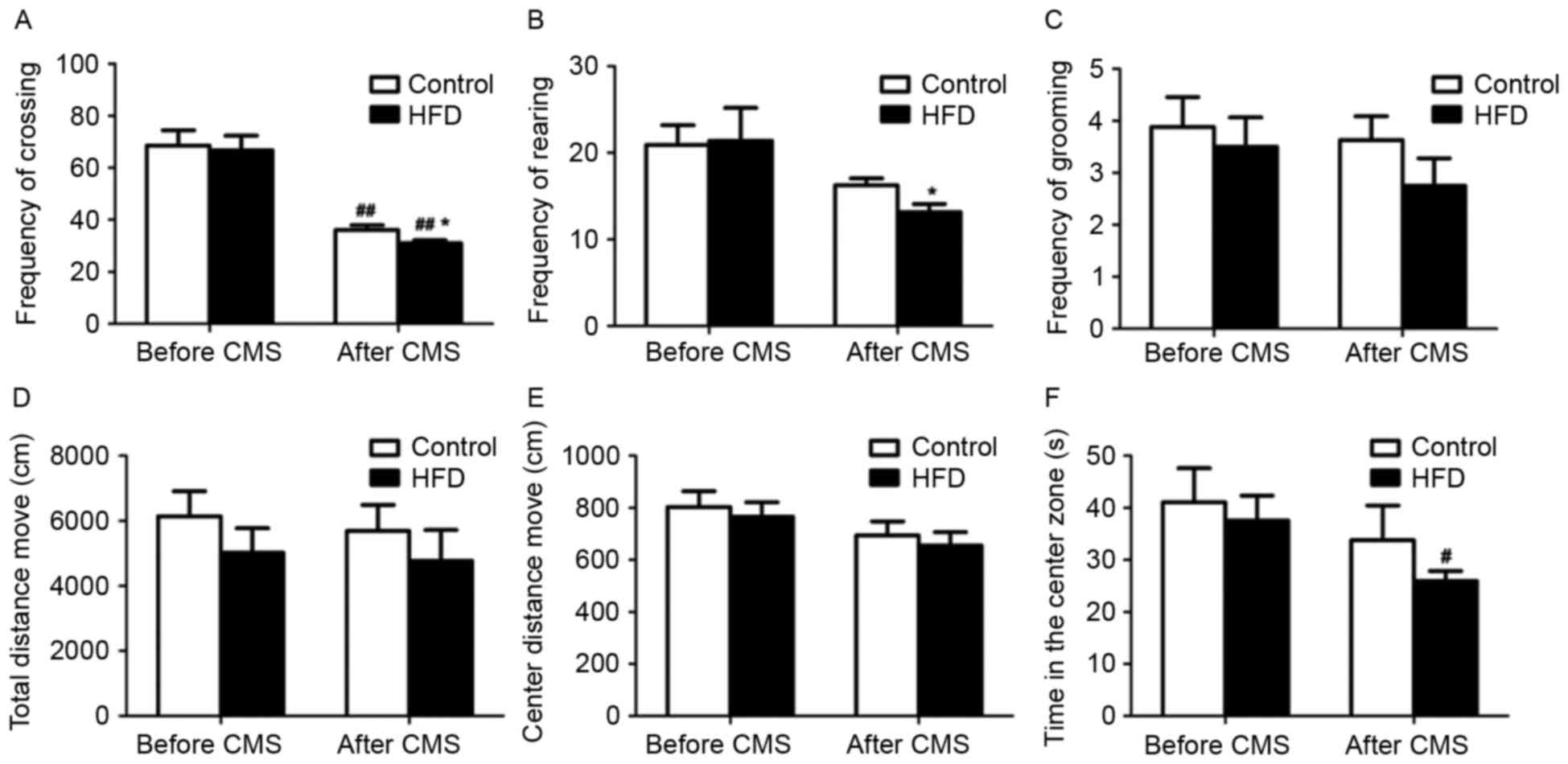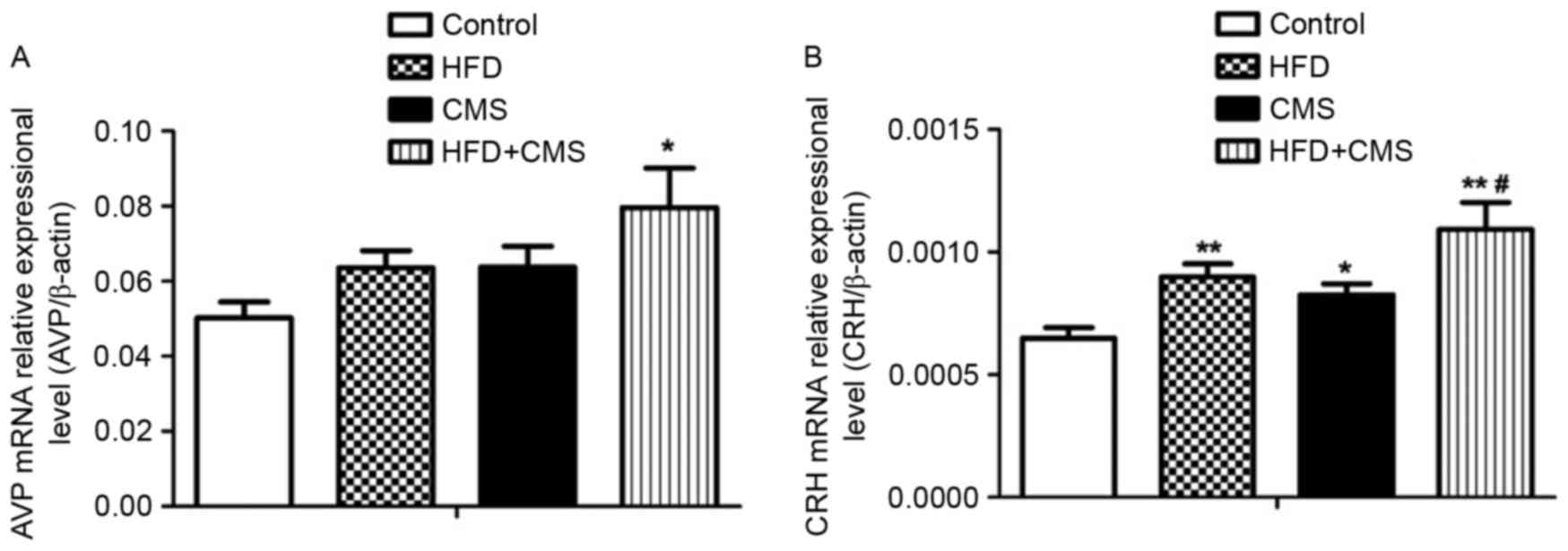|
1
|
Peleg-Raibstein D, Luca E and Wolfrum C:
Maternal high-fat diet in mice programs emotional behavior in
adulthood. Behav Brain Res. 233:398–404. 2012. View Article : Google Scholar : PubMed/NCBI
|
|
2
|
Auvinen HE, Romijn JA, Biermasz NR, Pijl
H, Havekes LM, Smit JW, Rensen PC and Pereira AM: The effects of
high fat diet on the basal activity of the
hypothalamus-pituitary-adrenal axis in mice. J Endocrinol.
214:191–197. 2012. View Article : Google Scholar : PubMed/NCBI
|
|
3
|
Rofey DL, Kolko RP, Iosif AM, Silk JS,
Bost JE, Feng W, Szigethy EM, Noll RB, Ryan ND and Dahl RE: A
longitudinal study of childhood depression and anxiety in relation
to weight gain. Child Psychiatry Hum Dev. 40:517–526. 2009.
View Article : Google Scholar : PubMed/NCBI
|
|
4
|
O'Connor TG: Prenatal and postnatal
exposure to an unhealthy diet is associated with behavioural and
emotional problems in children. Evid Based Ment Health. 17:382014.
View Article : Google Scholar : PubMed/NCBI
|
|
5
|
Soulis G, Papalexi E, Kittas C and Kitraki
E: Early impact of a fat-enriched diet on behavioral responses of
male and female rats. Behav Neurosci. 121:483–490. 2007. View Article : Google Scholar : PubMed/NCBI
|
|
6
|
Boukouvalas G, Antoniou K, Papalexi E and
Kitraki E: Post weaning high fat feeding affects rats' behavior and
hypothalamic pituitary adrenal axis at the onset of puberty in a
sexually dimorphic manner. Neuroscience. 153:373–382. 2008.
View Article : Google Scholar : PubMed/NCBI
|
|
7
|
Boukouvalas G, Gerozissis K and Kitraki E:
Adult consequences of post-weaning high fat feeding on the
limbic-HPA axis of female rats. Cell Mol Neurobiol. 30:521–530.
2010. View Article : Google Scholar : PubMed/NCBI
|
|
8
|
Verma R, Balhara YP and Gupta CS: Gender
differences in stress response: Role of developmental and
biological determinants. Ind Psychiatry J. 20:4–10. 2011.PubMed/NCBI
|
|
9
|
Szabo K and Hennerici MG: The Hippocampus
in Clinical Neuroscience. Front Neurol Neurosci Basel Karger. 2014.
View Article : Google Scholar
|
|
10
|
Li SX, Yan SY, Bao YP, Lian Z, Qu Z, Wu YP
and Liu ZM: Depression and alterations in
hypothalamic-pituitary-adrenal and hypothalamic-pituitary-thyroid
axis function in male abstinent methamphetamine abusers. Hum
Psychopharmacol. 28:477–483. 2013. View
Article : Google Scholar : PubMed/NCBI
|
|
11
|
Moreno-Ramos OA, Lattig MC and González
Barrios AF: Modeling of the hypothalamic-pituitary-adrenal
axis-mediated interaction between the serotonin regulation pathway
and the stress response using a Boolean approximation: A novel
study of depression. Theor Biol Med Model. 10:592013. View Article : Google Scholar : PubMed/NCBI
|
|
12
|
Holsboer F and Ising M: Central CRH system
in depression and anxiety-evidence from clinical studies with CRH1
receptor antagonists. Eur J Pharmacol. 583:350–357. 2008.
View Article : Google Scholar : PubMed/NCBI
|
|
13
|
Sasaki A, De Vega WC, St-Cyr S, Pan P and
McGowan PO: Perinatal high fat diet alters glucocorticoid signaling
and anxiety behavior in adulthood. Neuroscience. 240:1–12. 2013.
View Article : Google Scholar : PubMed/NCBI
|
|
14
|
García-Díaz DF, Campion J, Milagro FI,
Lomba A, Marzo F and Martínez JA: Chronic mild stress induces
variations in locomotive behavior and metabolic rates in high fat
fed rats. J Physiol Biochem. 63:337–346. 2007. View Article : Google Scholar : PubMed/NCBI
|
|
15
|
Stöhr T, Szuran T, Welzl H, Pliska V,
Feldon J and Pryce CR: Lewis/Fischer rat strain differences in
endocrine and behavioural responses to environmental challenge.
Pharmacol Biochem Behav. 67:809–819. 2000. View Article : Google Scholar : PubMed/NCBI
|
|
16
|
Willner P: Validity, reliability and
utility of the chronic mild stress model of depression: A 10-year
review and evaluation. Psychopharmacology (Berl). 134:319–329.
1997. View Article : Google Scholar : PubMed/NCBI
|
|
17
|
Willner P, Muscat R and Papp M: Chronic
mild stress-induced anhedonia: A realistic animal model of
depression. Neurosci Biobehav Rev. 16:525–534. 1992. View Article : Google Scholar : PubMed/NCBI
|
|
18
|
Muscat R and Willner P: Suppression of
sucrose drinking by chronic mild unpredictable stress: A
methodological analysis. Neurosci Biobehav Rev. 16:507–517. 1992.
View Article : Google Scholar : PubMed/NCBI
|
|
19
|
Patterson ZR, Ducharme R, Anisman H and
Abizaid A: Altered metabolic and neurochemical responses to chronic
unpredictable stressors in ghrelin receptor-deficient mice. Eur J
Neurosci. 32:632–639. 2010. View Article : Google Scholar : PubMed/NCBI
|
|
20
|
Westenbroek C, Ter Horst GJ, Roos MH,
Kuipers SD, Trentani A and den Boer JA: Gender-specific effects of
social housing in rats after chronic mild stress exposure. Prog
Neuropsychopharmacol Biol Psychiatry. 27:21–30. 2003. View Article : Google Scholar : PubMed/NCBI
|
|
21
|
Patterson ZR and Abizaid A: Stress induced
obesity: Lessons from rodent models of stress. Front Neurosci.
7:1302013. View Article : Google Scholar : PubMed/NCBI
|
|
22
|
Hou DR, Wang Y, Zhou L, Chen K, Tian Y,
Song Z, Bao J and Yang QD: Altered angiotensin-converting enzyme
and its effects on the brain in a rat model of Alzheimer disease.
Chin Med J (Engl). 121:2320–2323. 2008.PubMed/NCBI
|
|
23
|
Zhang L, Xu D, Zhang B, Liu Y, Chu F, Guo
Y, Gong J, Zheng X, Chen L and Wang H: Prenatal food restriction
induces a hypothalamic-pituitary-adrenocortical axis-associated
neuroendocrine metabolic programmed alteration in adult offspring
rats. Arch Med Res. 44:335–345. 2013. View Article : Google Scholar : PubMed/NCBI
|
|
24
|
Xinxing W, Wei L, Lei W, Rui Z, Baoying J
and Lingjia Q: A neuroendocrine mechanism of co-morbidity of
depression-like behavior and myocardial injury in rats. PLoS One.
9:e884272014. View Article : Google Scholar : PubMed/NCBI
|
|
25
|
Liu L, Liu F, Kou H, Zhang BJ, Xu D, Chen
B, Chen LB, Magdalou J and Wang H: Prenatal nicotine exposure
induced a hypothalamic-pituitary-adrenal axis-associated
neuroendocrine metabolic programmed alteration in intrauterine
growth retardation offspring rats. Toxicol Lett. 214:307–313. 2012.
View Article : Google Scholar : PubMed/NCBI
|
|
26
|
Livak KJ and Schmittgen TD: Analysis of
relative gene expression data using real-time quantitative PCR and
the 2(−Delta Delta C(T)) Method. Methods. 25:402–408. 2001.
View Article : Google Scholar : PubMed/NCBI
|
|
27
|
Bao AM, Meynen G and Swaab DF: The stress
system in depression and neurodegeneration: Focus on the human
hypothalamus. Brain Res Rev. 57:531–553. 2008. View Article : Google Scholar : PubMed/NCBI
|
|
28
|
Woods SC, Seeley RJ, Rushing PA, D'Alessio
D and Tso P: A controlled high-fat diet induces an obese syndrome
in rats. J Nutr. 133:1081–1087. 2003.PubMed/NCBI
|
|
29
|
McAllan L, Keane D, Schellekens H, Roche
HM, Korpela R, Cryan JF and Nilaweera KN: Whey protein isolate
counteracts the effects of a high-fat diet on energy intake and
hypothalamic and adipose tissue expression of energy
balance-related genes. Br J Nutr. 110:2114–2126. 2013. View Article : Google Scholar : PubMed/NCBI
|
|
30
|
Nelovkov A, Philips MA, Kõks S and Vasar
E: Rats with low exploratory activity in the elevated plus-maze
have the increased expression of limbic system-associated membrane
protein gene in the periaqueductal grey. Neurosci Lett.
352:179–182. 2003. View Article : Google Scholar : PubMed/NCBI
|
|
31
|
Hoogenboom WS, Perlis RH, Smoller JW,
Zeng-Treitler Q, Gainer VS, Murphy SN, Churchill SE, Kohane IS,
Shenton ME and Iosifescu DV: Limbic system white matter
microstructure and long-term treatment outcome in major depressive
disorder: A diffusion tensor imaging study using legacy data. World
J Biol Psychiatry. 15:122–134. 2014. View Article : Google Scholar : PubMed/NCBI
|
|
32
|
Winter SS, Köppen JR, Ebert TB and Wallace
DG: Limbic system structures differentially contribute to
exploratory trip organization of the rat. Hippocampus. 23:139–152.
2013. View Article : Google Scholar : PubMed/NCBI
|
|
33
|
Sasaki A, De Vega W, Sivanathan S, St-Cyr
S and McGowan PO: Maternal high-fat diet alters anxiety behavior
and glucocorticoid signaling in adolescent offspring. Neuroscience.
272:92–101. 2014. View Article : Google Scholar : PubMed/NCBI
|
|
34
|
Knight EM, Martins IV, Gümüsgöz S, Allan
SM and Lawrence CB: High-fat diet-induced memory impairment in
triple-transgenic Alzheimer's disease (3xTgAD) mice is independent
of changes in amyloid and tau pathology. Neurobiol Aging.
35:1821–1832. 2014. View Article : Google Scholar : PubMed/NCBI
|
|
35
|
Sahin TD, Karson A, Balci F, Yazir Y,
Bayramgurler D and Utkan T: TNF-alpha inhibition prevents cognitive
decline and maintains hippocampal BDNF levels in the unpredictable
chronic mild stress rat model of depression. Behav Brain Res.
292:233–240. 2015. View Article : Google Scholar : PubMed/NCBI
|
|
36
|
Belda X, Ons S, Carrasco J and Armario A:
The effects of chronic food restriction on
hypothalamic-pituitary-adrenal activity depend on morning versus
evening availability of food. Pharmacol Biochem Behav. 81:41–46.
2005. View Article : Google Scholar : PubMed/NCBI
|
|
37
|
Kokavec A, Lindner AJ, Ryan JE and Crowe
SF: Ingesting alcohol prior to food can alter the activity of the
hypothalamic-pituitary-adrenal axis. Pharmacol Biochem Behav.
93:170–176. 2009. View Article : Google Scholar : PubMed/NCBI
|
|
38
|
Naert G, Ixart G, Maurice T,
Tapia-Arancibia L and Givalois L: Brain-derived neurotrophic factor
and hypothalamic-pituitary-adrenal axis adaptation processes in a
depressive-like state induced by chronic restraint stress. Mol Cell
Neurosci. 46:55–66. 2011. View Article : Google Scholar : PubMed/NCBI
|
|
39
|
Lawson EA, Holsen LM, Desanti R, Santin M,
Meenaghan E, Herzog DB, Goldstein JM and Klibanski A: Increased
hypothalamic-pituitary-adrenal drive is associated with decreased
appetite and hypoactivation of food-motivation neurocircuitry in
anorexia nervosa. Eur J Endocrinol. 169:639–647. 2013. View Article : Google Scholar : PubMed/NCBI
|
|
40
|
Shalev U, Tylor A, Schuster K, Frate C,
Tobin S and Woodside B: Long-term physiological and behavioral
effects of exposure to a highly palatable diet during the perinatal
and post-weaning periods. Physiol Behav. 101:494–502. 2010.
View Article : Google Scholar : PubMed/NCBI
|
|
41
|
Csabafi K, Jászberènyi M, Bagosi Z, Liptàk
N and Telegdy G: Effects of kisspeptin-13 on the
hypothalamic-pituitary-adrenal axis, thermoregulation, anxiety and
locomotor activity in rats. Behav Brain Res. 241:56–61. 2013.
View Article : Google Scholar : PubMed/NCBI
|
|
42
|
Kenny R, Dinan T, Cai G and Spencer SJ:
Effects of mild calorie restriction on anxiety and
hypothalamic-pituitary-adrenal axis responses to stress in the male
rat. Physiol Rep. 2:e002652014. View Article : Google Scholar : PubMed/NCBI
|
|
43
|
Sarubin N, Nothdurfter C, Schüle C, Lieb
M, Uhr M, Born C, Zimmermannc R, Bühner M, Konopka K, Rupprecht R
and Baghai TC: The influence of Hatha yoga as an add-on treatment
in major depression on hypothalamic-pituitary-adrenal-axis
activity: A randomized trial. J Psychiatr Res. 53:76–83. 2014.
View Article : Google Scholar : PubMed/NCBI
|
|
44
|
McElroy SL, Kotwal R, Malhotra S, Nelson
EB, Keck PE and Nemeroff CB: Are mood disorders and obesity
related? A review for the mental health professional. J Clin
Psychiatry. 65:634–651. 2004. View Article : Google Scholar : PubMed/NCBI
|
|
45
|
de Kloet ER, Vreugdenhil E, Oitzl MS and
Joëls M: Brain corticosteroid receptor balance in health and
disease. Endocr Rev. 19:269–301. 1998. View Article : Google Scholar : PubMed/NCBI
|
|
46
|
de Kloet ER, Sutanto W, van den Berg DT,
Carey MP, van Haarst AD, Hornsby CD, Meijer OC, Rots NY and Oitzl
MS: Brain mineralocorticoid receptor diversity: Functional
implications. J Steroid Biochem Mol Biol. 47:183–190. 1993.
View Article : Google Scholar : PubMed/NCBI
|
|
47
|
de Quervain DJ, Aerni A, Schelling G and
Roozendaal B: Glucocorticoids and the regulation of memory in
health and disease. Front Neuroendocrinol. 30:358–370. 2009.
View Article : Google Scholar : PubMed/NCBI
|
|
48
|
Zhe D, Fang H and Yuxiu S: Expressions of
hippocampal mineralocorticoid receptor (MR) and glucocorticoid
receptor (GR) in the single-prolonged stress-rats. Acta Histochem
Cytochem. 41:89–95. 2008. View Article : Google Scholar : PubMed/NCBI
|
|
49
|
de Kloet ER, Oitzl MS and Joëls M:
Functional implications of brain corticosteroid receptor diversity.
Cell Mol Neurobiol. 13:433–455. 1993. View Article : Google Scholar : PubMed/NCBI
|














